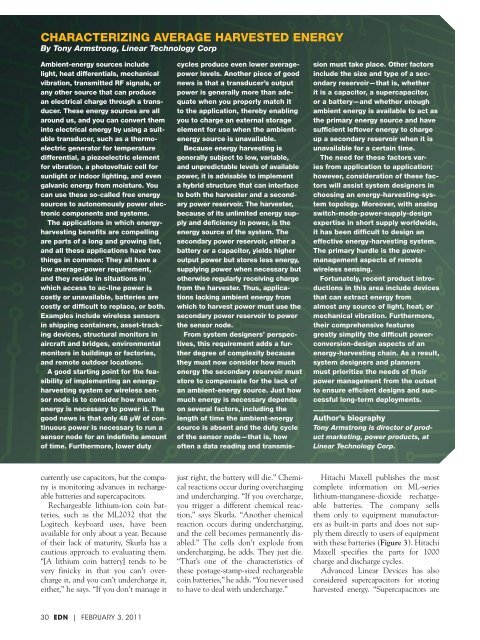VOICE OF THE ENGINEER - ElectronicsAndBooks
VOICE OF THE ENGINEER - ElectronicsAndBooks
VOICE OF THE ENGINEER - ElectronicsAndBooks
- No tags were found...
You also want an ePaper? Increase the reach of your titles
YUMPU automatically turns print PDFs into web optimized ePapers that Google loves.
CHARACTERIZING AVERAGE HARVESTED ENERGYBy Tony Armstrong, Linear Technology CorpAmbient-energy sources includelight, heat differentials, mechanicalvibration, transmitted RF signals, orany other source that can producean electrical charge through a transducer.These energy sources are allaround us, and you can convert theminto electrical energy by using a suitabletransducer, such as a thermoelectricgenerator for temperaturedifferential, a piezoelectric elementfor vibration, a photovoltaic cell forsunlight or indoor lighting, and evengalvanic energy from moisture. Youcan use these so-called free energysources to autonomously power electroniccomponents and systems.The applications in which energyharvestingbenefits are compellingare parts of a long and growing list,and all these applications have twothings in common: They all have alow average-power requirement,and they reside in situations inwhich access to ac-line power iscostly or unavailable, batteries arecostly or difficult to replace, or both.Examples include wireless sensorsin shipping containers, asset-trackingdevices, structural monitors inaircraft and bridges, environmentalmonitors in buildings or factories,and remote outdoor locations.A good starting point for the feasibilityof implementing an energyharvestingsystem or wireless sensornode is to consider how muchenergy is necessary to power it. Thegood news is that only 48 μW of continuouspower is necessary to run asensor node for an indefinite amountof time. Furthermore, lower dutycycles produce even lower averagepowerlevels. Another piece of goodnews is that a transducer’s outputpower is generally more than adequatewhen you properly match itto the application, thereby enablingyou to charge an external storageelement for use when the ambientenergysource is unavailable.Because energy harvesting isgenerally subject to low, variable,and unpredictable levels of availablepower, it is advisable to implementa hybrid structure that can interfaceto both the harvester and a secondarypower reservoir. The harvester,because of its unlimited energy supplyand deficiency in power, is theenergy source of the system. Thesecondary power reservoir, either abattery or a capacitor, yields higheroutput power but stores less energy,supplying power when necessary butotherwise regularly receiving chargefrom the harvester. Thus, applicationslacking ambient energy fromwhich to harvest power must use thesecondary power reservoir to powerthe sensor node.From system designers’ perspectives,this requirement adds a furtherdegree of complexity becausethey must now consider how muchenergy the secondary reservoir muststore to compensate for the lack ofan ambient-energy source. Just howmuch energy is necessary dependson several factors, including thelength of time the ambient-energysource is absent and the duty cycleof the sensor node—that is, howoften a data reading and transmissionmust take place. Other factorsinclude the size and type of a secondaryreservoir—that is, whetherit is a capacitor, a supercapacitor,or a battery—and whether enoughambient energy is available to act asthe primary energy source and havesufficient leftover energy to chargeup a secondary reservoir when it isunavailable for a certain time.The need for these factors variesfrom application to application;however, consideration of these factorswill assist system designers inchoosing an energy-harvesting-systemtopology. Moreover, with analogswitch-mode-power-supply-designexpertise in short supply worldwide,it has been difficult to design aneffective energy-harvesting system.The primary hurdle is the powermanagementaspects of remotewireless sensing.Fortunately, recent product introductionsin this area include devicesthat can extract energy fromalmost any source of light, heat, ormechanical vibration. Furthermore,their comprehensive featuresgreatly simplify the difficult powerconversion-designaspects of anenergy-harvesting chain. As a result,system designers and plannersmust prioritize the needs of theirpower management from the outsetto ensure efficient designs and successfullong-term deployments.Author’s biographyTony Armstrong is director of productmarketing, power products, atLinear Technology Corp.currently use capacitors, but the companyis monitoring advances in rechargeablebatteries and supercapacitors.Rechargeable lithium-ion coin batteries,such as the ML2032 that theLogitech keyboard uses, have beenavailable for only about a year. Becauseof their lack of maturity, Skurla has acautious approach to evaluating them.“[A lithium coin battery] tends to bevery finicky in that you can’t overchargeit, and you can’t undercharge it,either,” he says. “If you don’t manage itjust right, the battery will die.” Chemicalreactions occur during overchargingand undercharging. “If you overcharge,you trigger a different chemical reaction,”says Skurla. “Another chemicalreaction occurs during undercharging,and the cell becomes permanently disabled.”The cells don’t explode fromundercharging, he adds. They just die.“That’s one of the characteristics ofthese postage-stamp-sized rechargeablecoin batteries,” he adds. “You never usedto have to deal with undercharge.”Hitachi Maxell publishes the mostcomplete information on ML-serieslithium-manganese-dioxide rechargeablebatteries. The company sellsthem only to equipment manufacturersas built-in parts and does not supplythem directly to users of equipmentwith these batteries (Figure 3). HitachiMaxell specifies the parts for 1000charge and discharge cycles.Advanced Linear Devices has alsoconsidered supercapacitors for storingharvested energy. “Supercapacitors are30 EDN | FEBRUARY 3, 2011






![[270].pdf 37407KB Sep 02 2010 09:55:57 AM - ElectronicsAndBooks](https://img.yumpu.com/50350834/1/185x260/270pdf-37407kb-sep-02-2010-095557-am-electronicsandbooks.jpg?quality=85)
![draaien, A Viruly 1935 OCR c20130324 [320]. - ElectronicsAndBooks](https://img.yumpu.com/49957773/1/190x252/draaien-a-viruly-1935-ocr-c20130324-320-electronicsandbooks.jpg?quality=85)



![20051110 c20051031 [105].pdf 35001KB Feb 18 2009 08:46:32 PM](https://img.yumpu.com/48687202/1/190x253/20051110-c20051031-105pdf-35001kb-feb-18-2009-084632-pm.jpg?quality=85)




